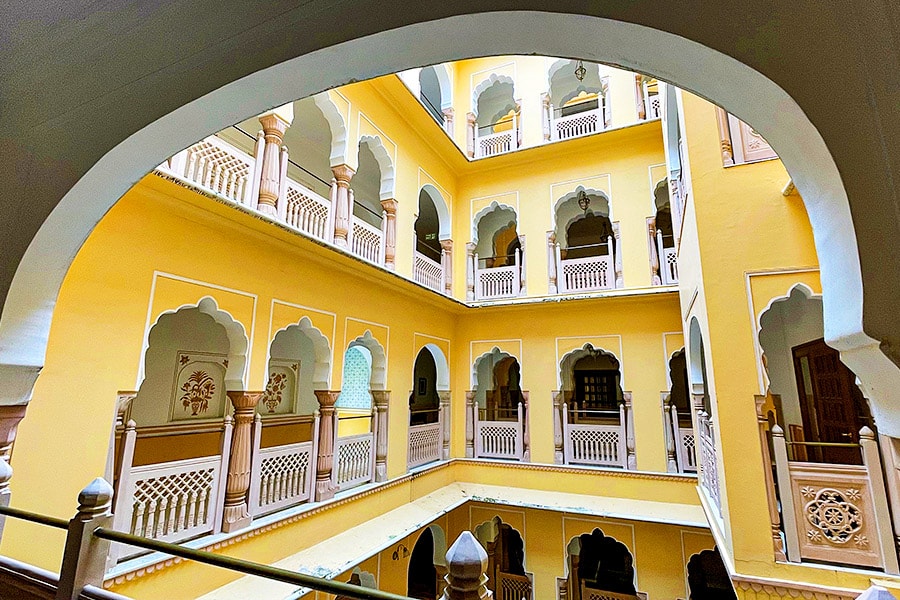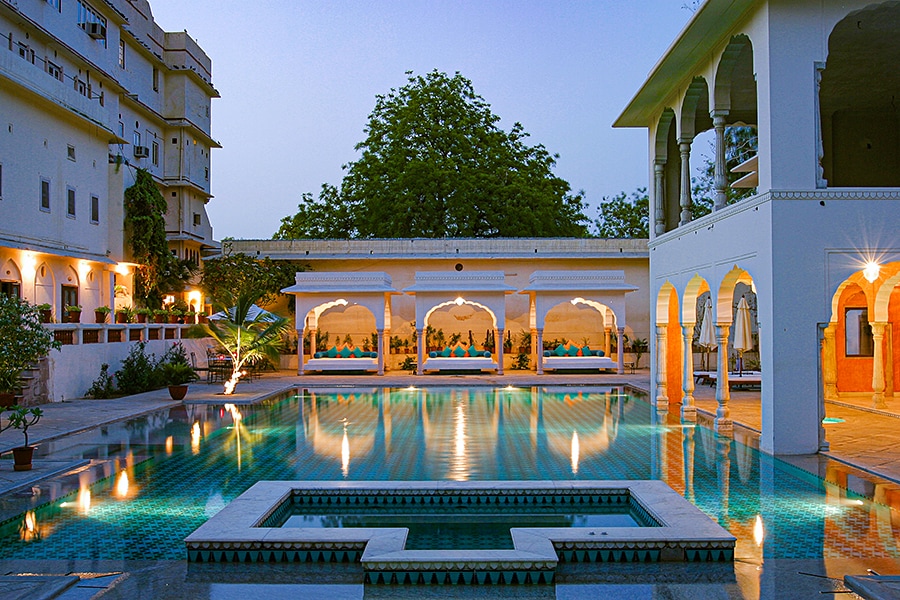
In this Rajasthani haveli, do as the Royals do
Every nook and cranny of Samode Haveli in Jaipur whispers tales of regal splendour
 The magnificent living room of Samode Haveli, where the walls are adorned from floor to ceiling with hand-painted frescoes, dating back to the illustrious 18th century
The magnificent living room of Samode Haveli, where the walls are adorned from floor to ceiling with hand-painted frescoes, dating back to the illustrious 18th century
While strolling through the labyrinthine passages of Samode Haveli, you can almost hear the echoes of laughter and music that once filled these inalienable halls. Straight out of a movie scene, this over two-centuries-old haveli steeped in history and opulence was once the exclusive domain of the privileged few. However, this epitome of refinement is now open to curious travellers, inviting them to step into a world of timeless beauty and captivating stories. The Samode Haveli in Jaipur exudes an aura of grandeur that only 225 years of history can bestow. Its grand entrance is a testament to its glorious heyday when its foundation was laid by the illustrious Rawals of Samode, forever etching their legacy into the annals of time.
Samode, a large town in Rajasthan, boasts a rich history of the mighty zamindars. These landlords, the principal thinkers of the state of Amber (Amer), held sway over parts of Rajasthan. The Thakur lineage, tracing back to the illustrious Maharaja Rajveer Singhji, the 17th prince of the esteemed house of Kacchwaha Rajputs, first put Samode on the map. However, under the rule of the British Raj, Samode was handed to the Nathawat clan, with the prestigious title of Rawal Saheb or Maha Rawal. The village and the title was bestowed upon them for their unwavering valiance and this lineage continues to thrive even to this very day.
“The Rawal clan played an integral role in the court of Jaipur including serving as the prime minister of the state for which they were awarded a prominent location for residence within the walled city. Like any noteworthy and erstwhile royal stately mansion, Samode Haveli has over the years hosted its fair share of dignitaries, social events and galas. Today, the Haveli gracefully embraces a dual identity as both a private residence for the family and as a luxury boutique hotel that continues to carry forward its long-standing tradition of extending ‘the quintessential Samode hospitality’ to global travellers. But one of my first recollections around the Haveli has been of my time playing cricket with family in the gardens next to the pool," says Rawal Yadavendra Singh, director of Samode Hotels, and a descendant of the family. The family continues to keep the top two floors of the haveli as their residence, shuttling between their three royal residences, Samode Palace, Samode Bagh and Samode Haveli, all in Jaipur.
What sets this haveli apart from the rest is its impeccable preservation, but this royal residence is not just a mere relic of the past, it is a living, breathing testament to the timeless allure of Jaipur. Being the ancestral home to the family, the Haveli interiors have been maintained to the greatest degree. The majority of the three-dimensional paintings and photographs at the Haveli date back to the late 1800s and speak of stories associated with the history of Samode. Most of the sheesham and teak wood furniture in the common areas is antique, including five standout cabinets and 15 trunks that belong to the family.
Rawal Yadavendra says, “The architectural and interior elements that you see at the Haveli stand as an epitome of traditional Rajputana design with influences of Indo-Saracenic grandeur. From the intricately inlaid doors, delicate filigree work, ethereal mural work, arched doorways, and courtyards to the jharokhas, the haveli tells a tale of artistic mastery and cultural fusion. The Palace and the Haveli were master crafted by masons and artisans who back then came from the Kumawat community from the Samode village. This community of artists and skilled painters today continue to be a part of Samode history and the ongoing conservation story—we continue to associate with them for all the restoration, renovations and touch-ups that are required across the Samode properties in Rajasthan."












